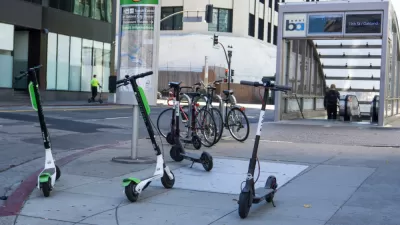Pathways that are used by cyclists and pedestrians have shown a high rate of collisions. Some say the regulations for these multi-use paths should be updated.
This piece from Grist looks at issues of safety and design in multi-use paths.
"[T]here's a disconnect between the speedy reality of bicycle transportation and the slow, recreational uses these trails are designed for. Multi-use paths are only required to be eight feet wide. That's fine for a stroll in the park, but when you factor in two lanes for bikes as well as joggers, skaters, and roving families, it's alarmingly narrow.
Most planning guidelines acknowledge that a 10-foot trail width is better, and recommend 12 for areas with heavy bicycle traffic. Even that -- as we learned on the Katy Trail, which is still being built to these state-of-the-art standards and even includes a narrower, supplemental trail for walking -- isn't enough when bikes are in the mix."
FULL STORY: We need real bike paths for real bike transportation

Planetizen Federal Action Tracker
A weekly monitor of how Trump’s orders and actions are impacting planners and planning in America.

Congressman Proposes Bill to Rename DC Metro “Trump Train”
The Make Autorail Great Again Act would withhold federal funding to the system until the Washington Metropolitan Area Transit Authority (WMATA), rebrands as the Washington Metropolitan Authority for Greater Access (WMAGA).

The Simple Legislative Tool Transforming Vacant Downtowns
In California, Michigan and Georgia, an easy win is bringing dollars — and delight — back to city centers.

The States Losing Rural Delivery Rooms at an Alarming Pace
In some states, as few as 9% of rural hospitals still deliver babies. As a result, rising pre-term births, no adequate pre-term care and harrowing close calls are a growing reality.

The Small South Asian Republic Going all in on EVs
Thanks to one simple policy change less than five years ago, 65% of new cars in this Himalayan country are now electric.

DC Backpedals on Bike Lane Protection, Swaps Barriers for Paint
Citing aesthetic concerns, the city is removing the concrete barriers and flexposts that once separated Arizona Avenue cyclists from motor vehicles.
Urban Design for Planners 1: Software Tools
This six-course series explores essential urban design concepts using open source software and equips planners with the tools they need to participate fully in the urban design process.
Planning for Universal Design
Learn the tools for implementing Universal Design in planning regulations.
Smith Gee Studio
City of Charlotte
City of Camden Redevelopment Agency
City of Astoria
Transportation Research & Education Center (TREC) at Portland State University
US High Speed Rail Association
City of Camden Redevelopment Agency
Municipality of Princeton (NJ)



























